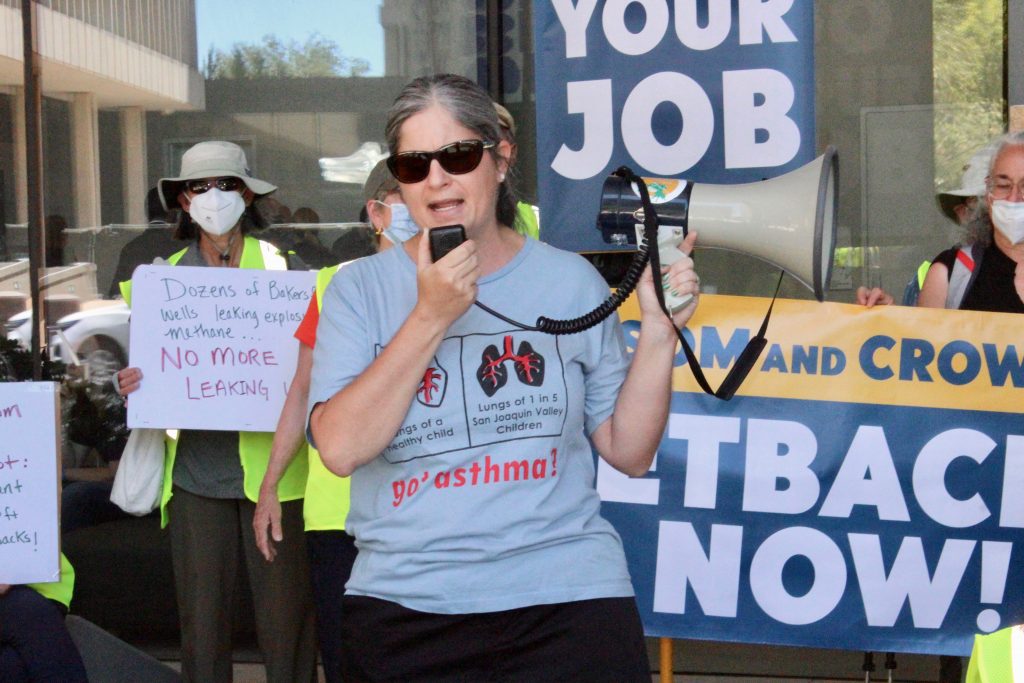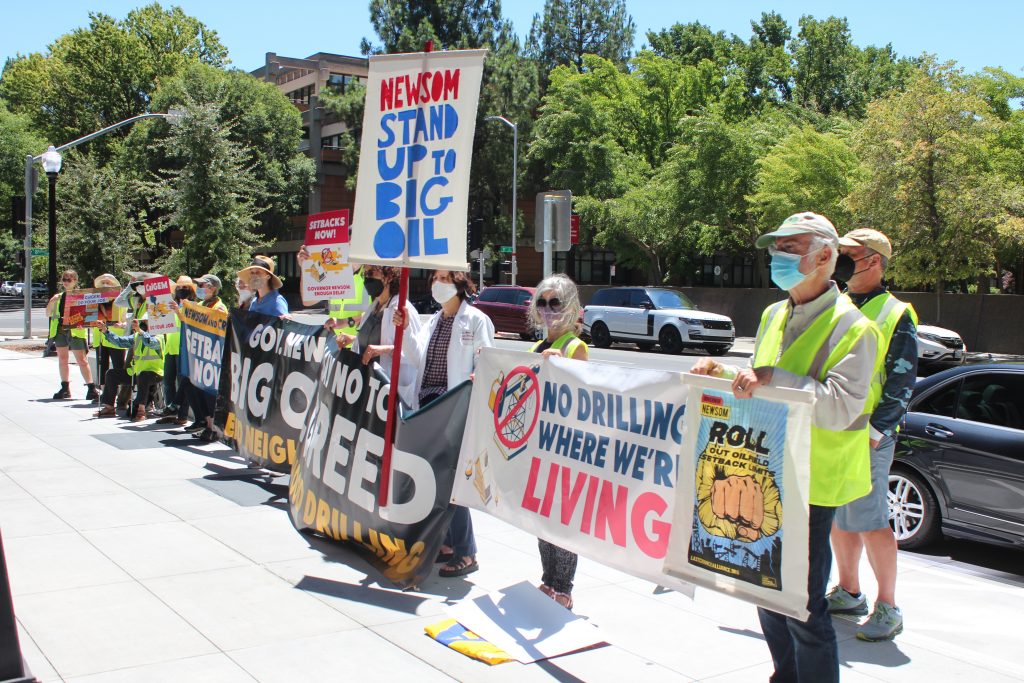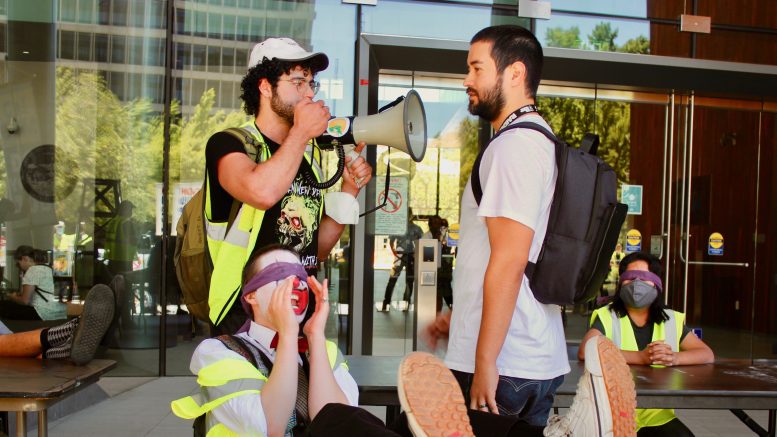Buzz around Newsom’s presidential hopes hampered by what state’s conservationists think of his policies and performance
By Dan Bacher
On July 13, dozens of residents and environmental justice advocates blocked the entrance to the California Department of Conservation headquarters in Downtown Sacramento. The protestors, many from Last Chance Alliance and VISION, were out to make a statement by erecting props, including wooden oil derricks, to represent what they described as the agency’s “negligent process” of desk monitoring through “remote witnessing” of oil wells near homes and schools.
While some activists sat in the “desks,” others carried signs and banners as they chanted through megaphones while converging on the headquarters of the state’s oil and gas regulatory agency, CalGEM. This came after the crowd had marched down from Roosevelt Park. They were demanding that Natural Resources Secretary Wade Crowfoot, and Governor Gavin Newsom, immediately take action on the ongoing issue of methane leaks from idle oil wells.
This protest action took place just as an analysis by Consumer Watchdog and the Fractracker Alliance revealed that the state’s approvals for permits to fix or deepen existing oil wells skyrocketed from last in the second quarter by some 124%. Meanwhile, second quarter permit approvals for oil drilling pushed the overall number since Newsom came to office to 11,669.
Those at the direct-action event called on Crowfoot and Newsom to end what they called CalGEM’s “long history of negligence” including the following:
- Stop “snapshot inspection quotas that CalGEM Whistleblowers say “only drive up numbers on a bar chart and make management look good.”
- Stop all “remote witnessing” of thousands of idle and decades-old toxic well sites and start “robust, in person site inspections.”
- Stop permitting toxic wells within 3200 feet of homes, schools, businesses, hospitals and other sensitive areas.
- Immediately roll out comprehensive 3200-foot setbacks on new and existing oil and gas well sites.
“Our action at CalGEM was a huge success,” said Kobi Naseck of VISION after the protest concluded. “Our message was heard loud and clear. CalGEM is unable to do its job and protect frontline communities. Our communities deserve setbacks now. We call on Governor Newsom and Secretary Wade Crowfoot to pass 3,200-foot setbacks now.”

Just last Friday, CalGEM noted that previously repaired wells were found leaking again and they discovered even more wells gushing methane, according to Naseck.
The environmental justice advocates also pointed out that 40 oil wells were found gushing methane as close as 100 yards from homes in North Bakersfield. Rather than immediately alerting nearby residents to this dangerous threat, Naseck noted that community members had to pressure the state oil regulator CalGEM to swiftly cap wells to protect their safety.
He also said whistleblowers have told the press that Uduak-Joe Ntuk, the head of the state agency, was “lying” about the severity of the threats posed by the leaking wells and that, “it’s a tragedy. Oversight integrity has gone sideways.”
Whistleblowers also observed that the agency has placed a quota on the amount of wells employees must inspect through “remote witnessing,” a process that allows regulators to avoid in-person inspections of California’s aging oil wells, including those near homes and schools, and instead “monitor” these sites from behind their desks.
Sacramento was not the only location where environmental justice advocates on Wednesday protested CalGEM’s failure to protect frontline communities from the dangerous health and environmental impacts of leaking oil and gas wells.
In Bakersfield, community members stood outside the entrance to the Inland field office with banners that called out employees for skimping on critical public health and safety monitoring of oilfields and failing to conduct onsite inspection of thousands of wells over the past two years.
“The Governor and Natural Resources Secretary Wade Crowfoot like to claim that they’re climate champions, but the reality couldn’t be further from the truth,” said Cesar Aguirre, a Kern County organizer with Central California Environmental Justice Network. “Their proposed health and safety rule is yet again stalled in a failed agency that won’t even go into the field to monitor the state’s riskiest and oldest oil infrastructure in-person. It’s clear that they are willing to ignore this public health emergency. Our communities are done waiting. CalGEM needs to do their job.”
“Now, yet another scandal shows us that state oil regulators are still not doing their job to protect Californians,” stated Shosana Wechsler, coordinator with Sunflower Alliance. “An agency name change, and new supervisor have not changed a thing. CalGEM needs new leadership from someone with a genuine commitment to environmental justice and robust regulation.”
She wasn’t the only one making those points.
“Pollution from oil and gas operations causes asthma and other breathing problems, may cause cognitive decline and cancer; it affects babies even before they are born,” stressed Marjaneh Moini, board member, Physicians for Social Responsibility. “We must phase out oil and gas infrastructure to truly protect public health, that is exactly what CalGEM scientific advisory panel has recommended. A 3,200-foot buffer between Californians and industrial oil operations is the bare minimum to protect their health, their livelihoods and their families.”
Sierra Club Senior Campaign Representative Jasmine Vazin echoed similar concerns.
“Our communities are tired of being neglected by our leaders and paying the public health and environmental price for it,” Vazin said. “We’ve felt the consequences of their inaction as dangerous amounts of methane spew into the air near Bakersfield homes, schools, and a day care center. But these leaking wells are merely the tip of the iceberg that is California’s idle and orphan well problem. We stand beside the community members demanding Governor Newsom put their public safety first and foremost and address the toxic drilling activities that are going on in our backyards.”

The Governor’s office said in a statement: “In the last few weeks, state oil and gas regulators have discovered idle oil wells leaking methane in Kern County. The state has taken urgent action to ensure these wells are properly remediated and operators are held accountable.”
Yet the agency admitted last Friday that five previously repaired wells were leaking again and they discovered two new wells spewing methane. For environmentalists, this is disconcerting, in light of the revelation that state approvals for permits to fix or deepen existing oil wells skyrocketed so dramatically.
“These are permit approvals to rework old wells that the oil industry wants to squeeze dry,” said consumer advocate Liza Tucker. “The state makes it far cheaper for oil companies to continue beating a dead horse than cement those wells shut, including wells that will never come back online or only produce 10 or 15 barrels of crude a day. State policy is misguided. Newsom should mandate that any wells near or in neighborhoods and any that are idle for more than a few years or barely producing oil should be shuttered to stop and prevent leaks.”
Tucker noted that Bakersfield residents over the past month have discovered more than 40 idle wells leaking methane and volatile organic compounds (VOCs) belonging to five different oil companies in suburban subdivisions of the city. Residents experienced fatigue, headaches and stomachaches. VOCs can negatively affect breathing, the nervous system and cause cancer.
“This can be attributed to CalGEM’s policy of conducting many of their inspections remotely from regulators’ desks, rather than conducting in-person inspections at the well sites in the field,” said Kyle Ferrar, a coordinator for FracTracker Alliance. “Oil and gas companies can use these reworks to continue to kick the bucket down the road instead of paying the necessary costs to plug these idle wells. That’s because there is very little oversight from CalGEM and no repercussions for leaking wells, as we have seen in Bakersfield.”
“It is critically important that the public has access to the list of ide wells as many could be leaking in urban and suburban settings and residents don’t even know that they are there,” added Tucker. “There are tens of thousands of these wells and they can be like ticking time-bombs for nearby communities.”


Be the first to comment on "For environmentalists, Sacramento is ground zero in battle over California’s air, coastlines and climate future"